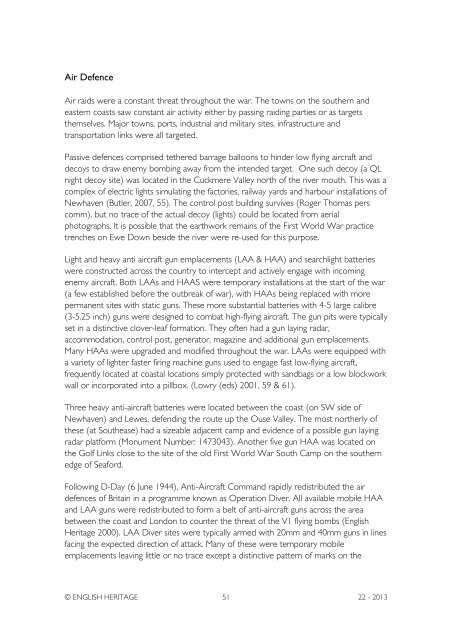Aerial Investigation and Mapping Report - English Heritage
Aerial Investigation and Mapping Report - English Heritage
Aerial Investigation and Mapping Report - English Heritage
You also want an ePaper? Increase the reach of your titles
YUMPU automatically turns print PDFs into web optimized ePapers that Google loves.
Air DefenceAir raids were a constant threat throughout the war. The towns on the southern <strong>and</strong>eastern coasts saw constant air activity either by passing raiding parties or as targetsthemselves. Major towns, ports, industrial <strong>and</strong> military sites, infrastructure <strong>and</strong>transportation links were all targeted.Passive defences comprised tethered barrage balloons to hinder low flying aircraft <strong>and</strong>decoys to draw enemy bombing away from the intended target. One such decoy (a QLnight decoy site) was located in the Cuckmere Valley north of the river mouth. This was acomplex of electric lights simulating the factories, railway yards <strong>and</strong> harbour installations ofNewhaven (Butler, 2007, 55). The control post building survives (Roger Thomas perscomm), but no trace of the actual decoy (lights) could be located from aerialphotographs. It is possible that the earthwork remains of the First World War practicetrenches on Ewe Down beside the river were re-used for this purpose.Light <strong>and</strong> heavy anti aircraft gun emplacements (LAA & HAA) <strong>and</strong> searchlight batterieswere constructed across the country to intercept <strong>and</strong> actively engage with incomingenemy aircraft. Both LAAs <strong>and</strong> HAAS were temporary installations at the start of the war(a few established before the outbreak of war), with HAAs being replaced with morepermanent sites with static guns. These more substantial batteries with 4-5 large calibre(3-5.25 inch) guns were designed to combat high-flying aircraft. The gun pits were typicallyset in a distinctive clover-leaf formation. They often had a gun laying radar,accommodation, control post, generator, magazine <strong>and</strong> additional gun emplacements.Many HAAs were upgraded <strong>and</strong> modified throughout the war. LAAs were equipped witha variety of lighter faster firing machine guns used to engage fast low-flying aircraft,frequently located at coastal locations simply protected with s<strong>and</strong>bags or a low blockworkwall or incorporated into a pillbox. (Lowry (eds) 2001, 59 & 61).Three heavy anti-aircraft batteries were located between the coast (on SW side ofNewhaven) <strong>and</strong> Lewes, defending the route up the Ouse Valley. The most northerly ofthese (at Southease) had a sizeable adjacent camp <strong>and</strong> evidence of a possible gun layingradar platform (Monument Number: 1473043). Another five gun HAA was located onthe Golf Links close to the site of the old First World War South Camp on the southernedge of Seaford.Following D-Day (6 June 1944), Anti-Aircraft Comm<strong>and</strong> rapidly redistributed the airdefences of Britain in a programme known as Operation Diver. All available mobile HAA<strong>and</strong> LAA guns were redistributed to form a belt of anti-aircraft guns across the areabetween the coast <strong>and</strong> London to counter the threat of the V1 flying bombs (<strong>English</strong><strong>Heritage</strong> 2000). LAA Diver sites were typically armed with 20mm <strong>and</strong> 40mm guns in linesfacing the expected direction of attack. Many of these were temporary mobileemplacements leaving little or no trace except a distinctive pattern of marks on the© ENGLISH HERITAGE 51 22 - 2013

















